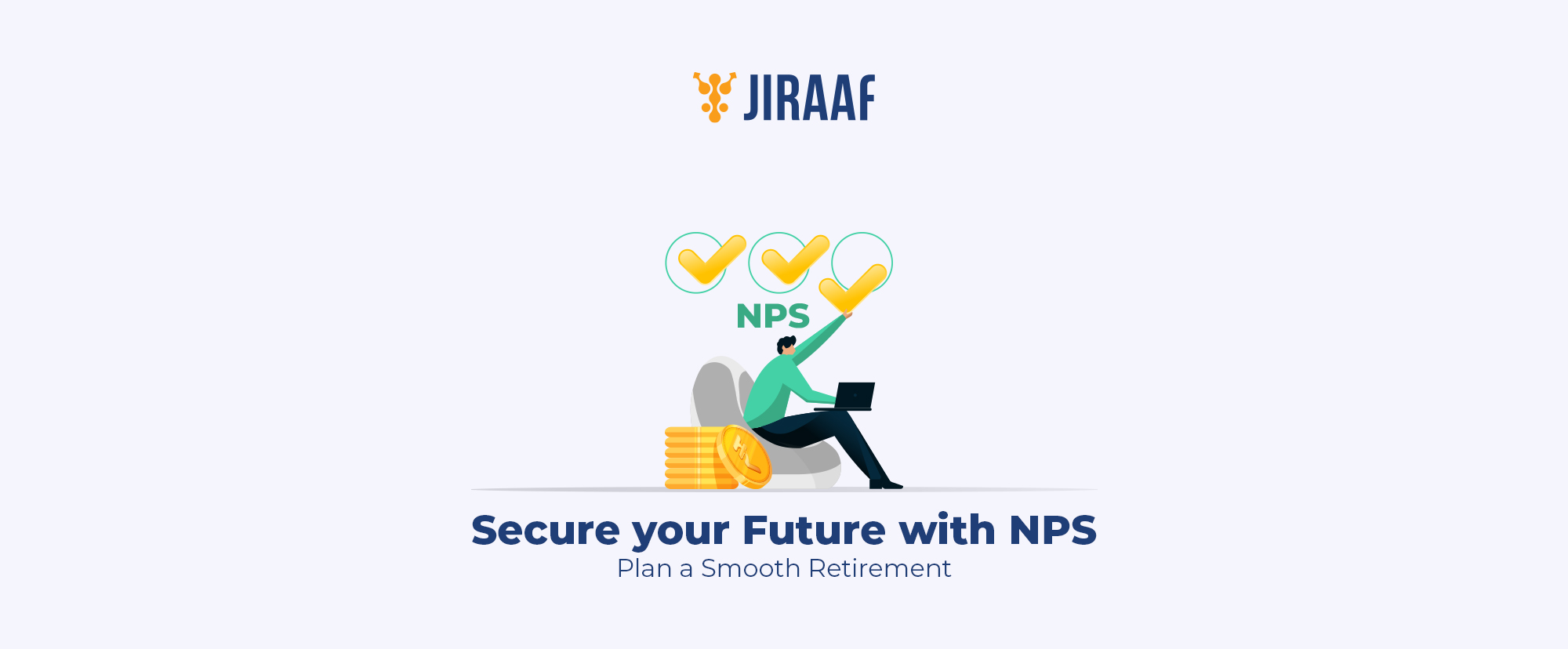Are you an aggressive saver, shrewd investor, or on a journey towards wealth creation, whatever your investment style is, the National Pension Scheme (NPS) offers excellent opportunities you wouldn’t want to overlook. In the past decade, NPS has gained popularity among individuals of all ages due to its investor-friendly features and flexibility. With the increasing awareness of retirement planning and a rising number of salaried investors embracing early retirement, the subscriber base of NPS is growing rapidly.
This blog aims to provide you with enough information on NPS, the process of signing up, its benefits, the paperwork, returns, and withdrawal details associated with this scheme.
What is National Pension Scheme (NPS)?
The National Pension Scheme, commonly known as NPS, is an initiative started by the Central Government. Earlier, it was only open to Central Government employees, but now people from public, private and the unorganized sectors can apply for it.
This scheme basically allows citizens to contribute regularly to a pension account during the years that they are employed, with the option to withdraw a portion of the corpus during retirement. The remaining amount is used to buy an annuity, ensuring a stream of steady income post-retirement. It also has tax benefits under Section 80C and Section 80 CCD.
Types of NPS Accounts
NPS offers two account types for subscribers:
Tier I:
The primary retirement account with withdrawal restrictions is designed for long-term planning and tax benefits. Withdrawals from this account are allowed at retirement (at 60 years) or under specific circumstances.
Tier II:
This account provides flexibility in withdrawals and is suitable for short-term goals. However, you will not get any additional tax benefits.
Tier 1 Vs. Tier II:
When comparing the two account types, it is important to consider their distinct features. Tier II gives higher returns, but it is relatively riskier than Tier I, while Tier 1 follows a conservative approach for lower risk. On the other hand, Tier I offers higher long-term benefits including tax benefits, while Tier II provides liquidity benefits. Choosing between them depends on goals, risk tolerance, and liquidity needs. Based on past subscriber behavior Tier I is much preferred for retirement planning and tax benefits, over Tier II.
Benefits of National Pension Scheme
The NPS is an integrated investment and pension plan that has a plethora of benefits that you would want to take advantage of. Let us look closely and see how it can be beneficial to your financial plans:
Income Generation
NPS is a source of income after retirement particularly for those of you who work in the private sector. The scheme encourages employees to invest in a pension account regularly throughout their careers. Upon retirement (at the age of 60 years), subscribers can withdraw a certain proportion of their corpus, and the remaining will be received as a pension payout after their retirement.
Tax Breaks
The tax breaks of NPS are unmatchable among all other pension schemes. Subscribers who have already utilized the ₹1.5 lakh tax deduction under section 80C can further reduce their tax liability by contributing an additional ₹50,000 under section 80CCD.
Flexibility
Individuals who have signed up for the scheme have the flexibility to modify their asset allocation up to four times each year. Additionally, they can invest in diverse funds managed by varied fund managers including HDFC, ICICI or Axis. One can also opt for one of the three Lifecycle funds that dynamically adjust the asset mix as they get older.
Market Linked Returns
The ROI of NPS is based on how it performs in the stock market. Though these investments carry market risks its returns are mostly higher than the traditional debt instruments like FDs or PPF. It is strictly regulated by the PFRDA so the chances of malpractice are almost negligible.
NPS Eligibility
Eligibility for the NPS depends on the NPS models available in operation.
Government Sector National Pension System Model
This method is developed for government workers at the central and state levels, excepting those who are not in the military.
- Government workers give 10% of their salary to the NPS, and this is matched with an equal share from the government. The Central Government employees benefit from the 14% contribution of the government.
- This NPS model applies to all states except for West Bengal.
The Corporate Model of the National Pension System
The corporate model of NPS applies to the employees of the companies that are registered with the Registrar of Companies (ROC) in the state or union territory where the company is located. The companies have to register themselves at the Ministry of Corporate Affairs (MOC) as well. They can also benefit from the NPS. Thus, in order to be eligible for this scheme , you need to:
- Be an Indian national, who is from 18 to 60 years old
- Fulfill KYC requirements
This model is applicable to the following:
- Companies that are registered under the Companies Act
- Late Co-Operative Acts by the partnership
- Central or Public Sector Enterprises
- Proprietary concerns
- Partnership firms or LLPs
- The companies that are incorporated by order from the State or Central Governments
- Societies or trusts
All Citizens Model of NPS
All Indian citizens who meet the following criteria can voluntarily enroll and contribute to the NPS for retirement security:
- Be between 18 and 60 years of age at the time of application
- Meet KYC requirements as specified in the Subscriber Registration Form and provide all necessary documentation
How to Open NPS Account?
Open NPS Account Online:
It is very quick and easy to open a PRAN account online. To register for NPS, visit enps.nsdl.com, choose document type (Aadhaar, PAN, or Digi locker), and select application type and residential status. Be careful in choosing the account type (Tier 1, Tier II, or both) and provide your details. Tier 1 offers tax benefits and Tier II offers more flexibility. Select pension fund managers and investment options, and do not miss to enter nominee information. Authenticate the relevant details and finally download the PRAN card with the unique 12-digit number.
Open NPS Account Offline:
To open an NPS account, visit the POP-Service Provider (POP-SP), which is the branch network providing NPS services. Fill out the registration form and submit it with mandatory KYC documents and initial contributions. Your application will be sent to Central Record Keeping Agency (CRA) for PRAN and they will provide the account details and password to access the PRAN account.
Documents Required for PRAN
The Mandatory documents that need to be submitted for PRAN:
- Recent photograph
- Proof of identity – Aadhaar, Passport
- Proof of address – Voter’s id, driving license, Telephone bill, electricity bill
- Age/ date of birth proof – PAN Card or passport
- Overseas citizens will need to furnish their OCI card
National Pension Scheme Returns
The National Pension Scheme (NPS) offers returns based on the performance of the underlying assets in which contributions are invested. NPS allows you to invest in four asset classes: Equity, Corporate Bonds, Government Securities, and Alternative Assets. The returns you receive are market-linked; they can fluctuate based on the performance of these asset classes.
Here’s a breakdown of the types of returns you can expect from NPS across different asset classes:
1. Equity:
- Equity investments in NPS can offer high returns over the long term, typically ranging between 9% to 12%. Equity investments in NPS involve placing funds into the stock market by buying shares of publicly listed companies. These investments offer the potential for high returns, especially over the long term
2. Corporate Bonds:
- Corporate bonds have provided returns ranging from 8% to 10% annually. Funds are invested in high-quality debt instruments issued by corporations, offering more stable returns.
3. Government Securities:
- These investments are in government bonds, providing the safest option among the asset classes with lower but stable yields.
4. Alternative Assets:
- NPS invests in alternative investment options such as real estate, hedge funds, private equity, or infrastructure funds etc. These assets offer higher growth potential but come with higher risks.
5. Blended Returns
Since NPS allows a mix of these asset classes, the overall returns depend on the allocation you choose.
- You can manually decide the allocation across different asset classes (subject to a maximum of 75% in equities).
- The allocation is made based on your age, with higher equity allocation when you are younger and more allocation toward bonds and government securities as you age.
National Pension Scheme Withdrawal Rules
Withdrawal rules differ between the two Tier accounts. Tier 1 has more restrictions, while Tier II allows withdrawals at any time. Tier 1 is considered more complex but offers tax benefits. Tier II is voluntary and provides flexibility. To begin, contribute at least 10% of your salary to Tier 1, and consider Tier II as a supplement. Keep in mind that you cannot withdraw the entire NPS corpus at once; one portion is allowed to be withdrawn while the rest of the corpus needs to be used to purchase an annuity that pays regular installments.
NPS Premature Window
The NPS premature window is generally referred to as the conditions and process for withdrawing funds from the NPS before 60 years of age, i.e, before the retirement age. Since NPS is focused on investment made for retirement, the withdrawals before this age have some specific terms and conditions. There are rules and limitations for partial withdrawals from Tier I and Tier II accounts, and they can also be subject to tax under certain conditions. However, amounts withdrawn for specific purposes, like medical emergencies, might be tax exempt under certain sections of the Income Tax Act.
Bottom Line
Now that you know the real advantages of NPS, it is safe to say that it offers both tax advantages and good investment returns making it a great investment choice for everyone. However, it is always recommended to diversify the investments.
Discover fixed income investments with Jiraaf, a SEBI registered online bonds platform that educates and brings access to a wide array of bonds. Sign up today to explore diversified fixed income investment opportunities to support your goal-based wealth creation journey. Start investing!




